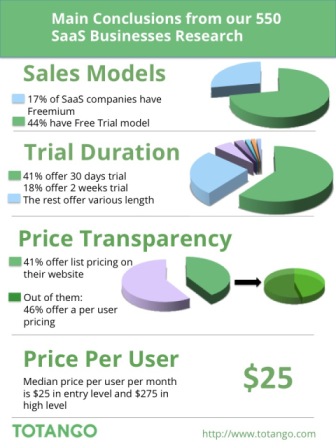SAAS – Software As A Service is in trend now as more and more people are getting accustomed to it and knowing its benefits. YOu can read about What is SAAS, PAAS and IAAS here. Reasons for SAAS popularity is that the software which you require can be used anywhere, anytime, and on any platform for a very little price, with out having the headaches of infrastructure, cost and availability, just like you use your ATM card to access money anywhere, anytime.
Pricing Strategy for SaaS
In any industry the price of the product or service is calculated based on two things
- Cost incurred in manufacturing/offering the products and service – this includes inventory, manufacturing, distribution, advertising and sales.
- The value it brings to the customer – this is the perceived value of your product or service in the customer perspective. It is a bit difficult to arrive at this amount but good amount of market research can give you an idea of value of your product.
When it comes to SaaS Product there are various cost which are listed below which will help you to zero down on your pricing.
- The cost of your time (if you were salaried ) and effort in building the product
- Your hosting and server costs
- Product specific cost which varies like infrastructure cost, billing system or payment gateway expense, etc
- Marketing, advertising, and Sales/distribution cost
- Cost of service and customer support
- Cost of customer Acquisition
- How unique and useful is your product
Pricing depends on your Sales Model
- How often do you want to charge – Will it be one time buy or monthly/yearly
- How many uses of your software – charge per user or limit of the number of uses
- Will it be Transactional charge – something like charge based on usage or per transaction.
- Different Plans – based on the complexity level you may want to offer multiple plan like starter, silver, gold plan etc.
- Enterprise Sales – SaaS Startups have products that provide so much value per customer and are so complex to buy that their natural starting point is traditional enterprise sales.
For the purposes of this discussion, it may be helpful to define some rough price points for web apps that fit into the three viable boxes. (via)
- Self-service: $10-$200 / month
- Low-End Transactional: $200-$3,000 / month
- High-End Transactional (“Enterprise”): $3,000-$6,000 / month
- Enterprise: $6,000-$40,000+ / month
 via http://visual.ly
via http://visual.ly
Revenue Model for SaaS
As we have discussed on this topic of Revenue model for APPS same is true for a SAAS product, but who is your customers determines your model i.e., is it B2B or B2C
1. Free for B2C
The Free model is actually an Ad-Supported model or something that helps a business leverage/popularize another brand or product. Most of the successful SAAS companies uses Free Model only for B2C (Business to Customers) Ex: Gmail, Facebook, Twitter, Youtube etc. If you are able to make a huge customer following then you can launch your know AD network like google, and Facebook, until then you have to support yourself by partnering with other advertising partners.
2. Freemium Model
This model can be used both on B2C and B2B and is usually used when your customer is a larger niche market. Take for example LinkedIn and Flickr. Freemium model Gives most of the features for free and charge extra for added premium features. Now what can be premium in your SaaS application depends on the market segment you are addressing to and/or the costs that you incur to enable you to provide the additional services. Free plans help the business generate more word of mouth and attract small businesses early on.
3. Free Trial and Paid only service
This is very successful model used by many B2B companies. Its a philosophy of try before you buy. To get the serious buyers use the trial offer many companies make it mandatory to enter the credit card details of the customer. Big Players in this model are Salesforce, Zoho, Adwords, mailchimp etc.
4 . White Labeling your SaaS Product
White labeling is a great way to market stuff. If you give enough commission people shouldn’t have a problem to market your product. (Make sure the code remains with you). Also make sure that the product is complex enough in terms of features before you pitch it to others so that they will prefer using your product instead of building a replica of their own. (A white-label product or service is a product or service produced by one company (the producer) that other companies (the marketers) re-brand to make it appear as if they made it.)
 Startup Freak Community for entrepreneurs and small businesses
Startup Freak Community for entrepreneurs and small businesses






One comment
Pingback: Pricing Strategies in Economics for Startups – Price Discrimination | Helping startups to grow